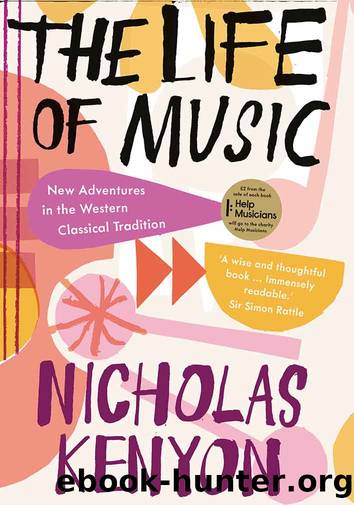The Life of Music by Nicholas Kenyon

Author:Nicholas Kenyon
Language: eng
Format: epub
ISBN: 9780300260601
Publisher: Yale University Press
12
Virtuosi
Musical eras are never clear cut: Beethovenâs revolutionary art both brings to a close the classical period of the extended eighteenth century and also inaugurates the individualised personal expression of the nineteenth century. This sense of the obligation on the composer to be original, rather than to be a craftsman within an already established framework, is an essential part of the Romantic imagination. This brings with it a developed (some might say over-developed) sense of the self, of the contribution that only you can bring to artistic expression, and privileges individuality above all else. It leads to the concept of the âgreatâ composer and the âgreatâ work which has dominated so much of our thinking from then to now. It also begins to heighten the importance of the âgreatâ performer as a public individual through whom music speaks; and when composer and performer came together, as we shall see they did with Paganini the violinist and Liszt the pianist, the result had an electrifying attraction for audiences.
This is clearly another tipping point for the story of music: the moment at which the focus on the court and patronage becomes widened to include the whole public appeal of concert-giving and music-making, under the impact of radical social change in the first part of the nineteenth century. This had a profound impact on music-making. The decline of the aristocracy, and thus of the patronage that had supported so many composers, gave way to a market-led economy which threw the emphasis onto public events competing for the attention of paying audiences. The establishment of a strongly middle-class model of concert attendance and participation was a major factor in the life of great European cities, and lent a sense of ownership of the form to those newly minted members of the middle classes who wished to demonstrate their credentials. This is not to say that the tastes of the new middle class were always elevated, and popular light music featured in many concerts, but there was an aspirational element to their concert-going which supported the creation of a central repertory.
The balance between the importance of European cultural centres began to shift. The unquestioned leadership of Vienna at the end of the eighteenth century, with the succession of Haydn, Mozart and Beethoven, started to falter as its repertory became less adventurous. It passed instead to the rival cities of Paris and London, both expanding rapidly and consciously promoting concert life for a newly acquisitive and upwardly mobile public. Another key European centre was Leipzig, where Bach had worked. The Gewandhaus had been founded as a municipal organisation in 1781 and was well established; it was the home of Mendelssohn and Schumann; and many others came to perform or study there: Chopin, Berlioz and Brahms visited, Mahler worked there learning to conduct opera, from England the young Arthur Sullivan (p. 188) came to study, and one of the dominating figures of the nineteenth century, Richard Wagner, was born there.
Soloists and conductors began to travel internationally. The
Download
This site does not store any files on its server. We only index and link to content provided by other sites. Please contact the content providers to delete copyright contents if any and email us, we'll remove relevant links or contents immediately.
Call Me by Your Name by André Aciman(18953)
Ready Player One by Cline Ernest(12828)
How to Be a Bawse: A Guide to Conquering Life by Lilly Singh(6686)
Wiseguy by Nicholas Pileggi(4582)
The Kite Runner by Khaled Hosseini(4416)
On Writing A Memoir of the Craft by Stephen King(4205)
The Crown by Robert Lacey(4099)
Audition by Ryu Murakami(4091)
Call me by your name by Andre Aciman(4065)
Harry Potter and the Cursed Child: The Journey by Harry Potter Theatrical Productions(3954)
Gerald's Game by Stephen King(3913)
The Perils of Being Moderately Famous by Soha Ali Khan(3781)
Dialogue by Robert McKee(3576)
Dynamic Alignment Through Imagery by Eric Franklin(3482)
Apollo 8 by Jeffrey Kluger(3196)
How to be Champion: My Autobiography by Sarah Millican(3181)
Seriously... I'm Kidding by Ellen DeGeneres(3098)
Darker by E L James(3086)
History of Dance, 2E by Gayle Kassing(2997)
